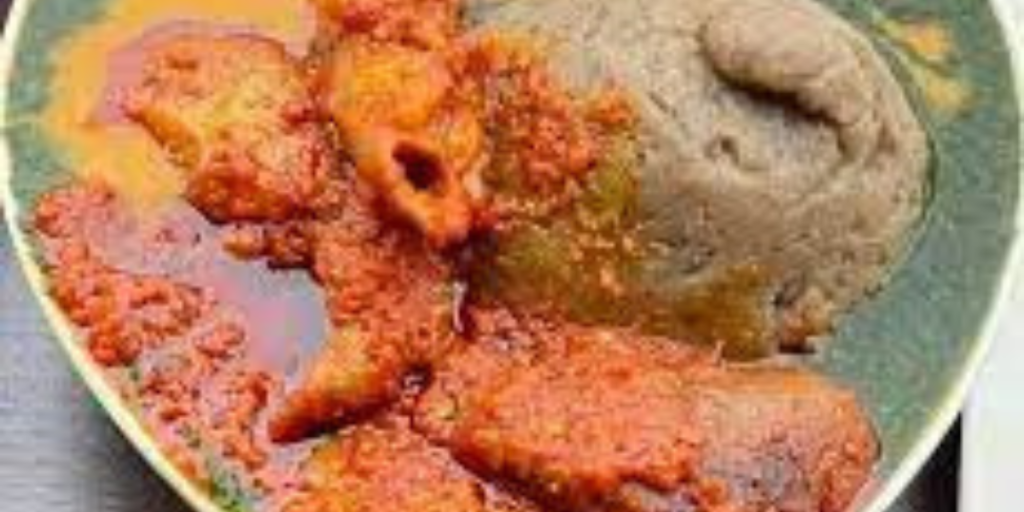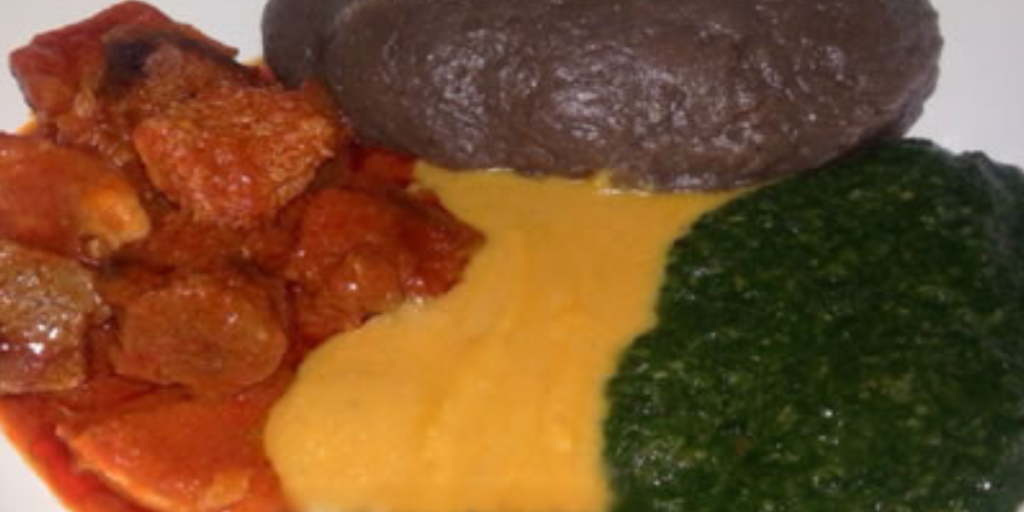Table of Contents

Amala and Ewedu, a beloved traditional dish, holds a special place in the hearts and kitchens of many Nigerians, particularly the Yoruba people of Southwestern Nigeria. This delectable combination of Amala, a smooth, stretchy dough made from yam flour, and Ewedu, a green, viscous soup made from jute leaves, is more than just a meal; it is a cultural emblem that signifies heritage, communal bonds, and the rich culinary traditions of the Yoruba people. Over time, this dish has transcended regional boundaries, becoming a household favorite across Nigeria and an easily accessible street food in bustling cities like Lagos.
The Rich History of Amala and Ewedu

Yoruba Culinary Heritage
The Yoruba people, one of the largest ethnic groups in Nigeria, are renowned for their vibrant culture, rich traditions, and exquisite cuisine. Among their many culinary treasures, Amala and Ewedu stand out as a dish deeply rooted in their history and daily life. The origins of Amala can be traced back to the need to utilize yam, a staple crop, in various forms. The process of turning yam into flour and then into a smooth dough has been perfected over generations, making Amala a quintessential Yoruba delicacy.
Ewedu, on the other hand, is made from jute leaves, a plant native to the region. The preparation of Ewedu soup involves meticulous processes to ensure the right texture and flavor, often enhanced with locust beans (iru) and a sprinkle of ground crayfish. This soup is not just a complement to Amala but a nutritious and wholesome dish in its own right.
Chin Chin | What is the Role of Egg in Chinchin?2024…
The Spread and Evolution
The cultural significance of Amala and Ewedu extends beyond the Yoruba heartland. As Yoruba people migrated to other parts of Nigeria and beyond, they carried their culinary traditions with them. Today, you can find Amala and Ewedu in various Nigerian cities, from Ibadan to Abuja, and even in Nigerian communities abroad. The dish has also evolved, with variations and adaptations that incorporate local ingredients and preferences.
Ingredients and Preparation

Amala Ingredients
To prepare authentic Amala, you need the following ingredients:
- Yam flour (Elubo)
- Water
Ewedu Ingredients
For the Ewedu soup, the ingredients include:
- Fresh jute leaves (Ewedu)
- Water
- Potash (Kaun) or baking soda (optional)
- Locust beans (Iru)
- Ground crayfish (optional)
- Salt to taste
Pancake :What Do You Need To Make Pancake In 2024
Preparation of Amala

- Boil Water: Start by boiling water in a pot. The amount of water you need depends on the quantity of Amala you want to prepare.
- Add Yam Flour: Once the water reaches a rolling boil, reduce the heat to medium and gradually add the yam flour. Stir continuously with a wooden spatula to avoid lumps.
- Mix Thoroughly: Keep mixing the flour into the water until it forms a smooth, stretchy dough. The consistency should be firm yet pliable.
- Steam and Serve: Cover the pot and allow the Amala to steam for a few more minutes. This helps to cook it evenly. Serve hot.
Preparation of Ewedu
- Prepare the Jute Leaves: Pick the jute leaves from the stems and rinse them thoroughly to remove any dirt.
- Blend the Leaves: In a pot, bring a small amount of water to a boil. Add the jute leaves and potash or baking soda (this helps to soften the leaves quickly). Blend the leaves using a traditional broom whisk (Ijabe) or a blender until they become smooth and viscous.
- Cook the Ewedu: Return the blended leaves to the pot and cook over medium heat. Add the locust beans, ground crayfish (if using), and salt to taste. Stir continuously until the soup thickens slightly and attains a slimy consistency.
- Serve: Ewedu is best served hot, often with a side of Gbegiri (bean soup) and assorted meats or fish.
What Is American Pancake Syrup? Best Description
Amala and Ewedu: A Street Food Sensation in Lagos

In the bustling city of Lagos, Amala and Ewedu have become more than just a home-cooked meal; they are a street food sensation. From high-end restaurants to roadside vendors, the availability of this dish has made it a go-to option for many Lagosians looking for a quick, satisfying, and nutritious meal.
Accessibility and Convenience
One of the reasons for the popularity of Amala and Ewedu on the streets of Lagos is its accessibility. Vendors often set up shop in strategic locations, making it easy for workers, students, and travelers to grab a plate on the go. The preparation process, while meticulous, can be scaled up to serve large numbers of people quickly, making it an ideal street food.
The Social Experience
Eating Amala and Ewedu is not just about the food itself; it’s about the experience. In Lagos, it’s common to see groups of people gathered around a vendor, sharing stories, laughing, and enjoying their meals together. This communal aspect of dining is a testament to the dish’s role in fostering social bonds and cultural continuity.
How to Make Chicken Yamarita Best recipe Of 2024
Amala and Ewedu: A Household Staple in Nigeria
Beyond the streets, Amala and Ewedu have solidified their place as a staple in Nigerian households. This is not just because of their delicious taste but also due to their nutritional benefits and the sense of cultural identity they provide.
Nutritional Benefits
Amala, made from yam flour, is rich in carbohydrates, providing a good source of energy. It also contains fiber, which aids in digestion. Ewedu, with its jute leaves, is packed with vitamins and minerals, including vitamins A and C, calcium, and iron. The addition of locust beans and crayfish to the soup further enhances its nutritional profile, offering protein and essential nutrients.
Cultural Significance
For many Yoruba families, preparing and eating Amala and Ewedu is a way to connect with their heritage. The dish is often served during special occasions, festivals, and family gatherings, symbolizing unity and tradition. It’s a reminder of their roots and a celebration of their cultural identity.
How to Make Yamarita: Best 2024 Recipe
Spreading the Love for Amala and Ewedu

In today’s digital age, social media plays a crucial role in promoting and sharing cultural experiences. Amala and Ewedu have not been left behind. Food bloggers, chefs, and enthusiasts regularly share their recipes, cooking tips, and dining experiences on platforms like Instagram, Facebook, and YouTube.
Instagram and Food Photography
Instagram, with its visual-centric approach, has become a favorite platform for sharing Amala and Ewedu dishes. The vibrant colors and unique textures of the meal make for stunning food photography. Hashtags like #AmalaandEwedu, #YorubaCuisine, and #NigerianFood help to connect people who share a love for this traditional dish.
YouTube and Cooking Tutorials
YouTube is another powerful platform where detailed cooking tutorials can be found. These videos not only show the preparation process but also provide insights into the cultural significance of Amala and Ewedu. Watching a skilled cook prepare the dish can be an educational and inspiring experience for viewers around the world.
Facebook and Community Engagement
On Facebook, groups and pages dedicated to Nigerian cuisine offer a space for people to share their experiences, recipes, and tips. These communities foster engagement and allow people to connect over their shared love for Amala and Ewedu, even if they are miles apart.
Frequently Asked Questions
What is Amala made of?
Amala is made from yam flour, also known as Elubo. The flour is mixed with hot water to create a smooth, stretchy dough.
How is Ewedu prepared?
Ewedu is prepared by blending fresh jute leaves with water and cooking them until they become a smooth, viscous soup. Ingredients like potash, locust beans, and ground crayfish can be added for flavor.
Can I make Amala with other types of flour?
While traditional Amala is made from yam flour, some people use plantain flour or cassava flour as alternatives. However, the texture and taste will differ from the original.
Is Amala and Ewedu healthy?
Yes, Amala and Ewedu are nutritious. Amala provides carbohydrates and fiber, while Ewedu is rich in vitamins, minerals, and antioxidants. The addition of locust beans and crayfish also contributes protein and other essential nutrients.
Where can I find yam flour?
Yam flour can be found in African grocery stores, international markets, or online. It’s often labeled as Elubo or Yam Flour.
Can I prepare Ewedu without potash?
Yes, you can prepare Ewedu without potash. Some people use baking soda as an alternative, or you can simply cook the leaves longer to achieve the desired consistency.
How do I store leftover Amala and Ewedu?
Leftover Amala can be stored in an airtight container in the refrigerator for up to 3 days. To reheat, sprinkle a little water and microwave or steam it. Ewedu can also be refrigerated for up to 3 days and reheated on the stove.
Conclusion
Amala and Ewedu are more than just a dish; they are a culinary journey that takes you through the heart of Yoruba culture and Nigerian cuisine. From their historical roots in Southwestern Nigeria to their widespread popularity across the country and beyond, this meal is a testament to the richness and diversity of African food traditions. Whether enjoyed at home with family or on the streets of Lagos, Amala and Ewedu continue to be a beloved part of the Nigerian dining experience.
Encouraging the sharing of this article on social media will help spread the love for Amala and Ewedu, allowing more people to discover and appreciate this delightful dish. So, the next time you savor a plate of Amala and Ewedu, remember that you’re not just eating a meal; you’re partaking in a cultural heritage that has been cherished for generations.
Feel free to share your own experiences, recipes, and photos of Amala and Ewedu on social media. Use hashtags like #AmalaandEweduRecipe, #NigerianFood, and #YorubaCuisine to connect with others who share your passion for this delicious dish.





















